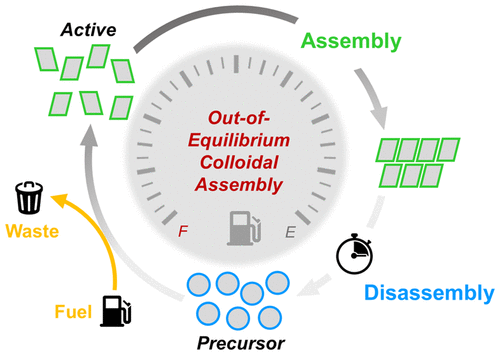Our official English website, www.x-mol.net, welcomes your
feedback! (Note: you will need to create a separate account there.)
Out-of-Equilibrium Colloidal Assembly Driven by Chemical Reaction Networks.
Langmuir ( IF 3.7 ) Pub Date : 2020-08-10 , DOI: 10.1021/acs.langmuir.0c01763 Bas G P van Ravensteijn , Ilja K Voets , Willem K Kegel 1 , Rienk Eelkema 2
Langmuir ( IF 3.7 ) Pub Date : 2020-08-10 , DOI: 10.1021/acs.langmuir.0c01763 Bas G P van Ravensteijn , Ilja K Voets , Willem K Kegel 1 , Rienk Eelkema 2
Affiliation

|
Transient assembled structures play an indispensable role in a wide variety of processes fundamental to living organisms including cellular transport, cell motility, and proliferation. Typically, the formation of these transient structures is driven by the consumption of molecular fuels via dissipative reaction networks. In these networks, building blocks are converted from inactive precursor states to active (assembling) states by (a set of) irreversible chemical reactions. Since the activated state is intrinsically unstable and can be maintained only in the presence of sufficient fuel, fuel depletion results in the spontaneous disintegration of the formed superstructures. Consequently, the properties and behavior of these assembled structures are governed by the kinetics of fuel consumption rather than by their thermodynamic stability. This fuel dependency endows biological systems with unprecedented spatiotemporal adaptability and inherent self-healing capabilities. Fascinated by these unique material characteristics, coupling the assembly behavior to molecular fuel or light-driven reaction networks was recently implemented in synthetic (supra)molecular systems. In this invited feature article, we discuss recent studies demonstrating that dissipative assembly is not limited to the molecular world but can also be translated to building blocks of colloidal dimensions. We highlight crucial guiding principles for the successful design of dissipative colloidal systems and illustrate these with the current state of the art. Finally, we present our vision on the future of the field and how marrying nonequilibrium self-assembly with the functional properties associated with colloidal building blocks presents a promising route for the development of next-generation materials.
中文翻译:

由化学反应网络驱动的非平衡胶体组装。
瞬时组装结构在生物体的多种基本过程中发挥着不可或缺的作用,包括细胞运输、细胞运动和增殖。通常,这些瞬态结构的形成是由分子燃料通过耗散反应网络的消耗驱动的。在这些网络中,构建块通过(一组)不可逆的化学反应从不活跃的前体状态转变为活跃(组装)状态。由于激活状态本质上不稳定并且只有在存在足够燃料的情况下才能维持,因此燃料耗尽会导致所形成的上部结构自发解体。因此,这些组装结构的特性和行为是由燃料消耗动力学决定的,而不是由它们的热力学稳定性决定的。这种燃料依赖性赋予生物系统前所未有的时空适应性和固有的自愈能力。出于对这些独特材料特性的着迷,最近在合成(超)分子系统中实现了将组装行为与分子燃料或光驱动反应网络耦合。在这篇特邀专题文章中,我们讨论了最近的研究,这些研究表明耗散组装不仅限于分子世界,还可以转化为胶体尺寸的构建块。我们强调了成功设计耗散胶体系统的关键指导原则,并用当前的技术水平来说明这些原则。最后,我们提出了对该领域未来的愿景,以及如何将非平衡自组装与胶体构件相关的功能特性相结合,为下一代材料的开发提供了一条有前途的途径。
更新日期:2020-09-15
中文翻译:

由化学反应网络驱动的非平衡胶体组装。
瞬时组装结构在生物体的多种基本过程中发挥着不可或缺的作用,包括细胞运输、细胞运动和增殖。通常,这些瞬态结构的形成是由分子燃料通过耗散反应网络的消耗驱动的。在这些网络中,构建块通过(一组)不可逆的化学反应从不活跃的前体状态转变为活跃(组装)状态。由于激活状态本质上不稳定并且只有在存在足够燃料的情况下才能维持,因此燃料耗尽会导致所形成的上部结构自发解体。因此,这些组装结构的特性和行为是由燃料消耗动力学决定的,而不是由它们的热力学稳定性决定的。这种燃料依赖性赋予生物系统前所未有的时空适应性和固有的自愈能力。出于对这些独特材料特性的着迷,最近在合成(超)分子系统中实现了将组装行为与分子燃料或光驱动反应网络耦合。在这篇特邀专题文章中,我们讨论了最近的研究,这些研究表明耗散组装不仅限于分子世界,还可以转化为胶体尺寸的构建块。我们强调了成功设计耗散胶体系统的关键指导原则,并用当前的技术水平来说明这些原则。最后,我们提出了对该领域未来的愿景,以及如何将非平衡自组装与胶体构件相关的功能特性相结合,为下一代材料的开发提供了一条有前途的途径。











































 京公网安备 11010802027423号
京公网安备 11010802027423号